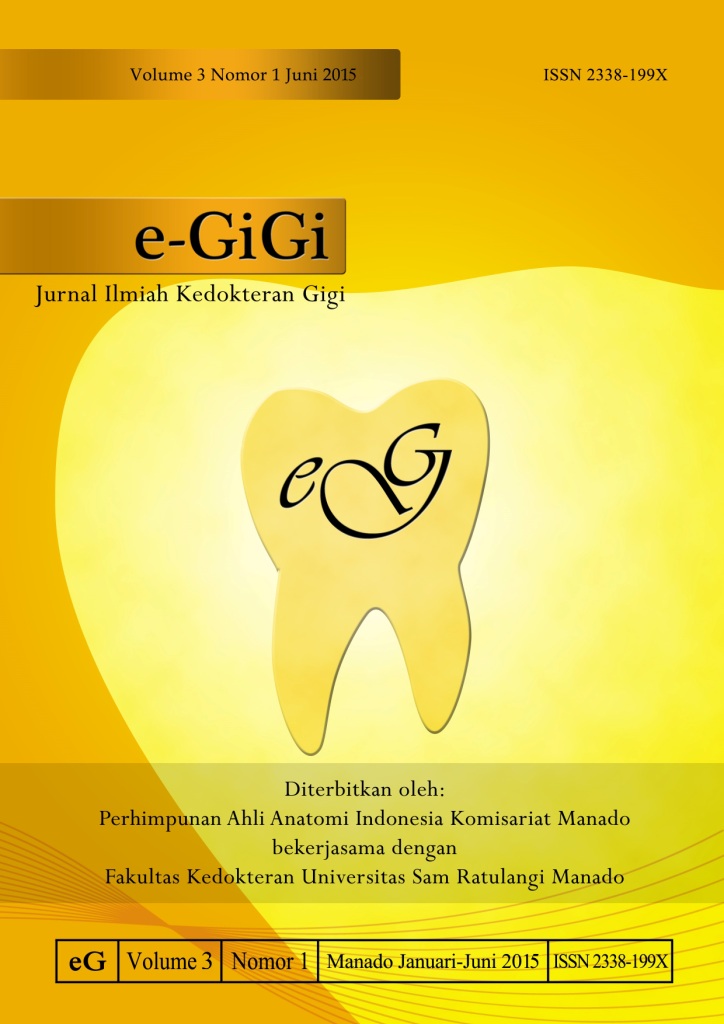STATUS KARIES ANAK USIA PRASEKOLAH SEKOLAH CITRA KASIH YANG MENGONSUMSI SUSU FORMULA
DOI:
https://doi.org/10.35790/eg.3.1.2015.6407Abstract
Abstract: Caries is disease on dental hard tissue that causes cavity in the tooth and on children is called rampant caries. Rampant caries occur because of the children who consume cariogenic foods and beverages as well as lack maintenance of oral hygiene. Formula milk is one of the food product that contain high nutritional value but can cause caries in children due to lack of proper feeding patterns like the duration of intake, frequency, duration, manner of presentation and means of prevention. The purpose of this study was to describe the caries status of preschool children in the Citra Kasih School who drink formula milk.This was a descriptive research with cross sectional study methods. The sample in this study amounted to 53 respondents with a total sampling technique based on the inclusion criteria.The results of caries status in children at school Citra Kasih Manado age 2-5 years old showed results d (decay) 36 respondents, e (Indicated for extraction) 29 respondents, and f (filled) 19 respondents, while based on formula milk feeding patterns obtained results the majority of preschooler students at Citra Kasih School Manado consume formula >2 years, the frequency of drinking milk >3 times daily, duration of drinking milk ≤ 15 minutes, without the addition of sugar, and not given water after consuming milk formula, and with an average def-t value of 1,6 according to the assessment def-t indicators from the WHO.Caries status of preschool children in the School Citra Kasih Manado who drink formula milk was classified in the low category.Keywords: caries status, preschoolers, formula milk
Abstrak: Karies merupakan suatu penyakit jaringan keras gigi yang menyebabkan kavitas pada gigi dan pada anak-anak disebut rampan karies. Rampan karies terjadi karena pola konsumsi makanan dan minuman yang bersifat kariogenik serta kurangnya pemeliharaan kebersihan gigi dan mulut anak. Susu formula merupakan salah satu produk makanan yang mengandung nilai gizi yang cukup tinggi namun dapat menyebabkan karies pada anak akibat pola pemberian yang kurang tepatseperti lama pemberian, frekuensi, durasi, cara penyajian dan cara pencegahan. Tujuan penelitian ini ialah untuk mengetahui gambaran status karies anak usia prasekolah di Sekolah Citra Kasih yang mengonsumsi susu formula.Penelitian ini merupakan penelitian deskriptif dengan metode pengambilan data yaitu cross sectional study. Sampel pada penelitian ini berjumlah 53 anak yang diperoleh menggunakan teknik total sampling sesuai kriteria inklusi.Hasil penelitian menunjukakan indeks def-t rata-rata anak yaitu 1,6 dengan nilai d (decay) 36, e (indicated for extraction) 29, dan f (filled) 19. Berdasarkan pola pemberian susu formula diperoleh hasil, mayoritas murid sekolah Citra Kasih Manado mengonsumsi susu formula > 2 tahun, frekuensi minum susu > 3 kali sehari, durasi minum susu ≤ 15 menit, tanpa adanya penambahan gula dan pemberian air putih setelah mengonsumsi susu formula.Status karies anak usia prasekolah di Sekolah Citra Kasih Manado yang mengonsumsi susu formula tergolong dalam kategori rendah.
Kata kunci: Status karies, anak usia prasekolah, susu formula
Downloads
Published
How to Cite
Issue
Section
License
COPYRIGHT
Authors who publish with this journal agree to the following terms:
Authors hold their copyright and grant this journal the privilege of first publication, with the work simultaneously licensed under a Creative Commons Attribution License that permits others to impart the work with an acknowledgment of the work's origin and initial publication by this journal.
Authors can enter into separate or additional contractual arrangements for the non-exclusive distribution of the journal's published version of the work (for example, post it to an institutional repository or publish it in a book), with an acknowledgment of its underlying publication in this journal.
Authors are permitted and encouraged to post their work online (for example, in institutional repositories or on their website) as it can lead to productive exchanges, as well as earlier and greater citation of the published work (See The Effect of Open Access).






